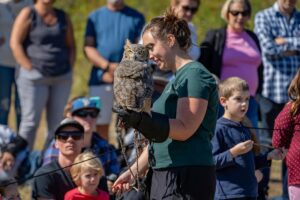
Have you ever wondered how the hawks, falcons, and eagles are trained to sit calmly on their handler’s glove or fly free over the heads of spectators at some zoos and wildlife conservation facilities? It may look easy, but training a wild raptor is nothing like training your dog. Once the facility has set up the proper enclosures and received all the proper licenses and permits required for the acquisition, care, keeping and flying of a raptor, the real hard work begins. A handler may take months or even years to properly train a wild raptor.
Equipment
Apart from a spacious, clean, safe enclosure, there is certain equipment necessary for glove or free-flight training a raptor:
- Gauntlet: A thick glove, usually leather, for protecting the handler’s hand and arm from talons and beaks.
- Jesses: Leather straps which are placed around the bird’s ankles and attach to a leash. There are many different styles of jesses to choose from.
- Swivel: Metal hardware for connecting the leash to the jesses, allowing for the bird’s movement on the glove.
- Leash: Attaches to the jesses via a clip on a swivel.
- Creance: A long tether on a reel for allowing a bird to fly a certain distance while still attached to the trainer.
Steps
The basic steps for training a raptor are taken from the ancient practice of falconry, and involve using food as motivation while desensitizing the bird to human closeness, noise, and activity.
- Jesses are attached to the bird to be trained. The bird is allowed to get used to having jesses around its ankles.
- The handler spends plenty of time in the raptor’s enclosure. At this point, humans should move slowly and speak quietly while bringing the raptor food. They may avoid prolonged eye contact or directly facing the bird, as this body language may signal aggression to the raptor. The goal is for the bird to feel comfortable preening, feeding and going about its business in the trainer’s presence.
- The bird is “manned.” This is a falconry term which means simply getting the bird used to sitting on a gloved hand. Usually, this is accomplished by leashing the bird to the handler’s glove and walking around with the bird for short periods at a time. The goal is for the bird to remain relaxed when exposed to a variety of stimulation.
- The bird eats on the glove. This is usually accomplished by careful monitoring of the bird’s weight. A fat hawk will not be motivated to step onto a human’s gloved arm to eat. A hungry bird who has previously spent time on the glove without coming to harm will overcome its natural fear responses and step up to the glove to feed. The handler holds tightly onto to the food or keeps the bird tethered to the glove so it does not simply grab the food and fly away.
- The bird to flies to the glove for food. The handler starts standing just a few feet away with the food. If the bird will not fly to the glove, he removes the food and tries again later. Carefully monitoring the bird’s weight helps the trainer to learn what weight the bird is willing to fly for food, and when the bird is too well-fed to want to bother. Over time, the trainer increases the distance the bird must fly for its dinner.
- Creance training. The trainer starts with allowing short flights, which gradually increase in distance.
- Once the bird will return easily to the glove from 65 feet away, the trainer is most likely able to free-fly the bird without a creance.
Overall, the raptor must be kept healthy and happy if its training is to work. Training or keeping any raptor in captivity is illegal without proper licensing. Falconers study their craft for years becoming licensed, and wildlife rehabilitators have their own training and licensing.
